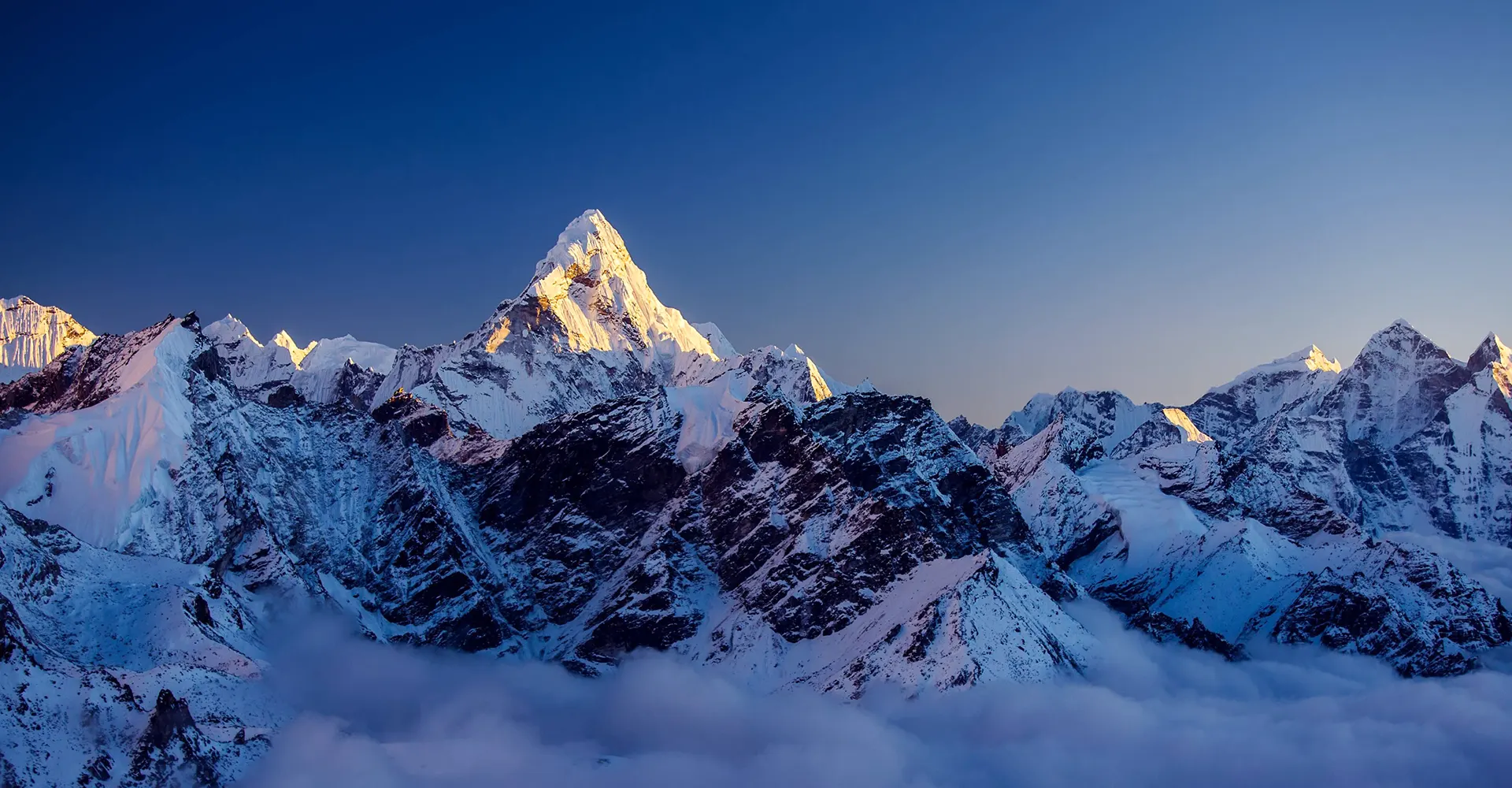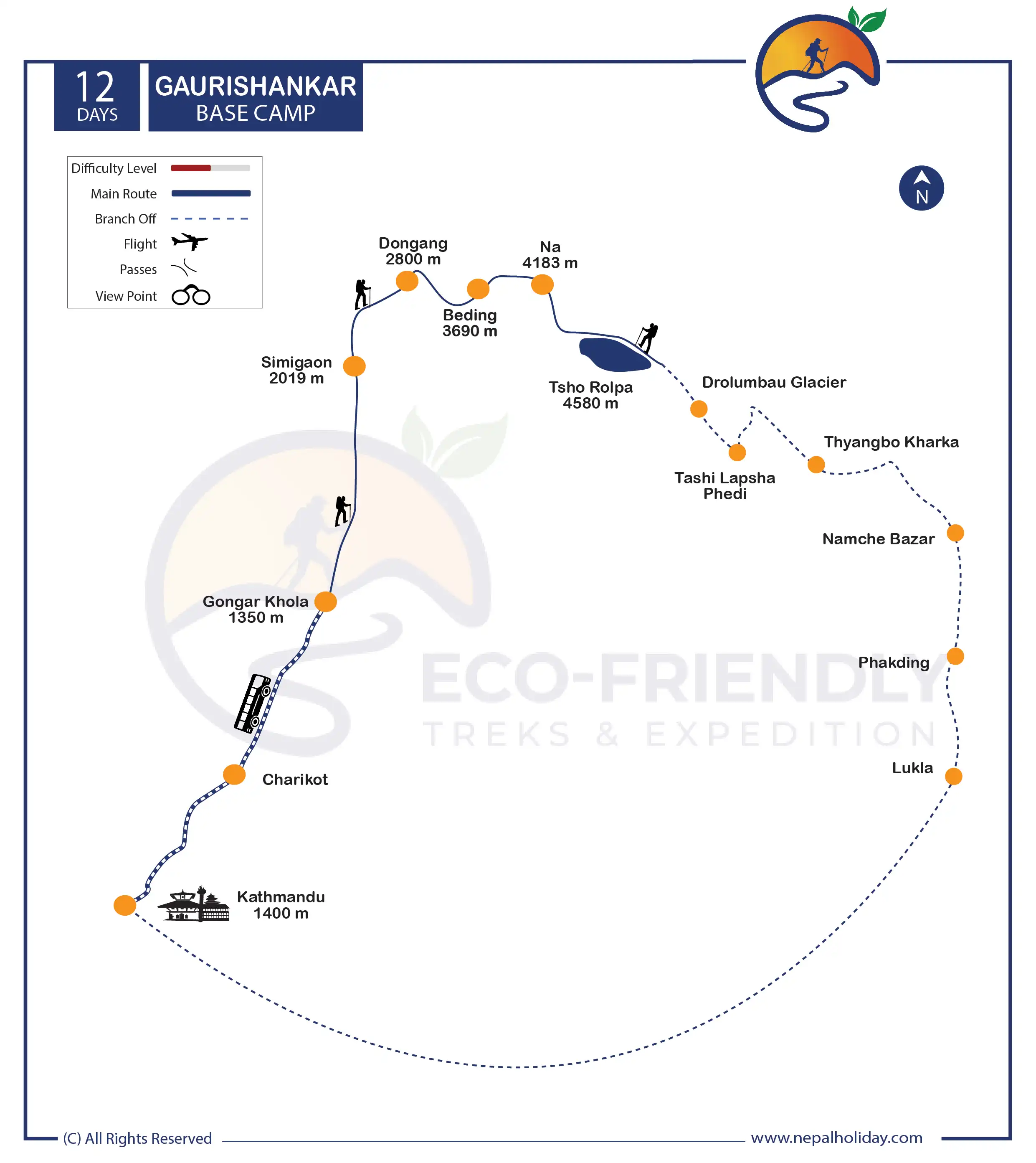Trip Introduction
Overview of Gaurishankar Trek
The Gaurishankar Trek, or Tsho Rolpa Lake Trek, is one of the lesser-known trekking routes. It begins in Rolwaling and ends at Tsho Rolpa, Nepal’s largest glacier lake. Despite its proximity to one of the most popular trekking destinations, the Everest region, Tsho Rolpa remains peaceful and remote. The hike includes a spectacular view of the Gaurishankar Himal (7134 m) from start to finish, in addition to the picturesque lake Tsho Rolpa.
The road to the trek’s beginning point (the trading town of Dolakha), located in the country’s northeastern area, follows the path from Kathmandu to Lhasa, Tibet.
There are interesting terraced fields, fast-flowing rivers, woodlands, and two wonderful glaciers to see, as well as the stunning glacial lake of Tso Rolpa. This journey begins at a low elevation, giving trekkers plenty of time to acclimate before reaching the lake. Although the trail does not reach high altitudes, trekking days are typically 6–8 hours long, requiring a high fitness level.
Among the mountains visible on this path are Gauri Shankar (7,145 m) and Menlungtse (7,181 m). The route passes through Brahmin, Chhetri, Tamang, and Sherpa communities, as well as Bigu Gompa, which houses over 300 nuns. The mani stones along the trail and prayer flags flying in the breeze indicate that this area is predominantly Buddhist.
This is a fantastic alternative trek for those who wish to avoid traveling at high elevations but are interested in the culture of the people of the Everest region.
Itinerary of Gaurishankar Trek
Includes/Excludes
What's Included?
- Drive from KTM to Ghongar Khola to KTM.
- Experienced Himalayan trek guide for 06 days
- One porter for two of you for trekking for 05 days (prepare to give max. 15 kgs’ luggage from each of you so that it will not exceed 30 kg. for your porter)
- Basic yet comfortable accommodation for 05 nights on a twin-sharing basis during the trekking as per itinerary.
- Staff insurance
- 06 x set breakfast, 06 x set lunch and 05x set dinner while on the trek
- Purified drinking water during the entire trekking as per itinerary
- General first aid medicine kit
- Complimentary T-shirt
- Duffle bag during the trek
What's Excluded?
- International Flight Fare
- Foods and Accommodation in Kathmandu since there are many possibilities available.
- Personal expenses of any kind
- Any Travel Insurance
- Any additional cost due to natural calamity and unforeseen circumstances that may lead to a change in itinerary.
- Tips for any staff and guide
- Anything that is not listed in the “PRICE INCLUDES” section above
Essential Information - Gaurishankar Trek
Gaurishankar Trek Route Map
The trek starts with a scenic drive from Kathmandu to Gonga Khola, which takes around 8–9 hours, and a trek the same day to Simigaon, which will take 2–3 hours. Along the way, you’ll pass through small villages and get a chance to meet the locals and learn about their way of life.
You’ll continue your trek to Dongang, passing through dense forests and several waterfalls. Further on, the trail takes you to Beding, a small village at the foot of the Tsho Rolpa glacier. It is a rest day in Beding, which will give you a chance to explore the village and take in the local culture. The next day, you will trek to Tsho Rolpa Lake, one of the main highlights of the trek, and then back to the village on the same day.
After that, you will be back on the same trail at Gongar Khola and then reach Kathmandu. Throughout the trek, you’ll have a chance to experience the natural beauty and cultural richness of Nepal, making memories that will last a lifetime.
Is the Gaurishankar Trek difficult?
The highest hill on this Gaurishankar Trek is Tsho Rolpa, which is 4580 m above sea level. Getting to this height is neither easy nor hard. The Rolwaling path is not difficult in terms of the technical climbs, but you do have to walk for 6–8 hours every day.
In the same way, you will gain 300–400 m every day. The scary thing about the Tsho Rolpa walk is not the route itself, but the height of the trail. So, you must have a lot of drive and be in good health. Most of the time, trekking to higher altitudes takes average physical fitness, a positive attitude, and a strong will.
Gaurishankar Trek Permit
To walk to Tsho Rolpa in the Rolwaling Valley, you must have a Gaurishankar Conservation Area entry permit. The entrance fee to the Gaurishankar Conservation Area is 3,000 NPR (about USD 30) for all foreign tourists and 1,000 NPR (approximately USD 10) for SAARC nationals. Aside from that, you’ll need a TIMS permit.
Accommodation on Gaurishankar Trek
The Gaurishankar Trail is dotted with lodges and teahouses where hikers can rest their heads for the night. These teahouses are basic yet pleasant, with amenities like beds and blankets and a common restroom. Meals, such as dal bhat (rice and lentil soup) and momos (dumplings), are available in the teahouses as well.
Expenses for lodging and food are not uniform across the country or even the year. As the height of your climb increases, you should expect your lodgings to become more primitive, with less access to modern conveniences like running water and electricity.
Food on Gaurishankar Trek
During your trek on the Tsho Rolpa trail, you’ll be able to try both traditional Nepalese food and some simple Western meals. Teahouses and hotels along the trekking route serve hearty meals like dal bhat (rice, lentil soup, and vegetables), momos (meat or vegetable-filled dumplings), noodles, fried rice, and curries. These meals give you the nutrients and energy you need for hiking at high altitudes. Hot drinks like tea, coffee, and hot chocolate are also served in teahouses.
Fresh fruits and vegetables may be harder to find at higher levels, but teahouses still serve basic meals and snacks like canned fruits and vegetables, instant noodles, biscuits, and energy bars. It’s important to remember that there may not be many food options in some places, so it’s a good idea to bring some snacks and energy bars as a backup.
Best season to trek Gaurishankar
The best times to do the Tsho Rolpa trek are in the spring (March to May) and autumn (September to November), when the weather is stable and clear. During these seasons, trekking is a great way to see the area because the days are sunny and the weather is warm. In the spring, the rhododendron forests are full of flowers, while in the fall, the mountains and landscapes can be seen clearly.
It’s important to remember that the weather in the mountains can change quickly, so it’s best to check the forecast before setting out on the hike. Planning ahead and making plans with a registered trekking agency can also help make sure that trekking is safe and fun.
Altitude Sickness & Acclimatization of Gaurishankar Trek
During the Gaurishankar trek, it’s important to know the signs of altitude sickness and to tell your trekking guide right away if you feel any of them. If your symptoms are bad, your guide may tell you to rest or go down to a lower height. Some trekking companies bring with them portable hyperbaric tanks that can be used to treat altitude sickness if it happens.
To avoid altitude sickness, it’s best to go up slowly, follow a good acclimatization schedule, stay hydrated, and eat foods that are high in carbs and calories. Don’t drink alcohol or smoke because they can make mountain sickness worse and make the body less hydrated. Most hikers can avoid altitude sickness and have a safe and enjoyable time on the Gaurishankar Trail if they follow these tips.
Gaurishankar Trek Packing Suggestions
Please pack your bags well for the porter. Each of you can bring 15 kg, and a porter has been set up for the two of you. The rest of your stuff will stay at your hotel until this trip is over. Here is a loose list of things to bring on the Gaurishankar Trek that might help you:
- Appropriate clothing (3 sets)
- Woolen sweater or jacket
- Thermal inner wear
- Wide-brimmed hat
- Woolen cap and scarf
- Thick woolen glove
- Water-proof glove
- Sport Sandals
- Woolen socks (2 pairs)
- Water-proof (not water-resistant) shoes with a good tread/grip
- Rain-proof pants and jacket with hood
- A lock for the duffle bag
- Backpack with water-proof cover
- Sleeping bag suitable for temperatures around 0°C (1 – optional)
- Down jacket with hood
- Camera (optional) (drone is not permitted by authority)
Other essential items:
- Personal clothing
- Toiletries
- Small thermos for hot beverages
- Water bottle (1 liter)
- Sunscreen lotion (50 SPF or more)
- Castor oil (50 ml) to lubricate the nostrils at high altitude
- Ziplock bags for clothing
- Quick-dry Towel (not a regular one)
- Toilet paper
- Wet wipes
- Sunglasses
- Snacks: chocolates, biscuits, nuts, etc.
- Hand sanitizer
- Powerful flashlight or headlamp (with extra batteries)
Medical Kit
When trekking in remote areas such as Tsho Rolpa, it’s crucial to carry a basic medical kit to handle minor injuries and illnesses. Here are some essential items to include:
- Pain relief medication: Ibuprofen, aspirin, or acetaminophen can ease pain from muscle soreness, headaches, or altitude sickness.
- Bandages and wound dressings: Pack a variety of bandages and dressings in different sizes to cover cuts, blisters, and other injuries. It’s also wise to include antiseptic wipes or creams to clean wounds.
- Medications for gastrointestinal issues: Stomach problems like diarrhea and nausea may occur during high-altitude trekking. Carry medications like loperamide or Pepto-Bismol to alleviate these symptoms.
- Insect repellent: Mosquitoes and other insects are prevalent in the region, and their bites can cause irritation and discomfort. Carry insect repellent to keep them at bay.
- Personal prescription medications: If you have any pre-existing medical conditions or allergies, bring your prescription medications along with a copy of the prescription.
- Consult with your doctor before trekking to Gaurishankar, and inform your trekking guide of any pre-existing medical conditions or allergies.
Communication in Gaurishankar Trek
In Nepal’s major cities, such as Kathmandu, you can acquire a local SIM card. However, it’s important to note that the Gaurishankar Trek has limited network coverage, which can result in weak or nonexistent signals.
While some teahouses and villages along the trek may have internet cafes, the connection is usually unreliable and slow.
Your trekking guide can be an excellent source of communication, as they may have access to a satellite phone or local knowledge of communication infrastructure.
Most asked questions
FAQs about Gaurishankar Trek
The Gauri Shankar Trek is an exceptional adventure that allows you to fully engage with the magnificent natural surroundings, local customs, and Himalayan culture in Nepal. The trek guides you through pristine and isolated areas, providing a unique chance to engage with the local community and experience their welcoming and kind hospitality firsthand.
Tso Rolpa Lake, located at an elevation of 4,183 m is the highest place during the Gaurishankar trek.
While on the trek, you can expect to hike for an average of 5 to 7 hours per day, with intermittent rests and lunch breaks. The length of each day’s trek will vary depending on the distance to be traveled, the elevation gain, and the challenges of the terrain.
The Gauri Shankar Trek is classified as a moderate-level trek, implying that it demands a certain level of physical fitness, endurance, and mental preparation. Consequently, individuals with low fitness levels may find it unsuitable for their capabilities.
If you plan to go on the Tsho Rolpa trek, you need to obtain a permit first. The trek is situated within the Gaurishankar Conservation Area, and it’s mandatory for trekkers to get a permit from the conservation area office in Kathmandu.
Customizing the Gauri Shankar Trek itinerary is possible to meet your specific preferences and requirements. The standard duration of the trek usually spans from 5 to 6 days but can be adjusted according to your fitness level, interests, and availability.
To extend your trek, additional rest days or side trips to nearby attractions and villages can be included. One recommended site to visit is the Tashi Lhapcha Pass, which boasts an altitude of 5,755m and presents breathtaking views of the Himalayan mountain ranges.
Trekking through the Gauri Shankar region is no easy feat, as the terrain can be tough to navigate, and the weather can be unpredictable. However, hiring a local guide who knows the area well can make all the difference. Not only can they help you avoid any hazards along the way and keep you safe, but they can also provide valuable insights into the local culture, customs, and history. Moreover, they can facilitate your interaction with the local communities, making your trekking experience more enriching.
Charging electronic devices while trekking can be difficult due to limited or non-existent access to electricity along the Gauri Shankar trail.
To ensure that trekkers are physically fit to tackle the challenges of high altitude trekking, medical tests are a necessary requirement. These tests can help identify any underlying health conditions or potential risks that could be exacerbated by the physical exertion and high altitude environment.
If you’re interested in taking your kids on the Gauri Shankar Trek, it’s certainly possible to book a trip. However, keep in mind that this trek requires a good level of physical fitness, endurance, and mental preparation. As such, it may not be a suitable adventure for young children or infants.
After you have made a booking for the Gauri Shankar Trek package, the trekking agency will send you a confirmation email or message containing the necessary details regarding your booking and payment process. Additionally, they will provide you with comprehensive information on the itinerary, accommodation, transportation, and other relevant details of the trek.
Prior to beginning the trek, we provide training and preparation for acclimatization to aid trekkers in adjusting to the high altitude and avoiding altitude sickness. The training typically involves spending several days at a lower altitude to enable the body to gradually adapt to the high altitude.
Reviews on Gaurishankar Trek
Be first to post a review in this trip.
© Copyright 2024 Eco-friendly Treks. Website Developed by: AVIVA




